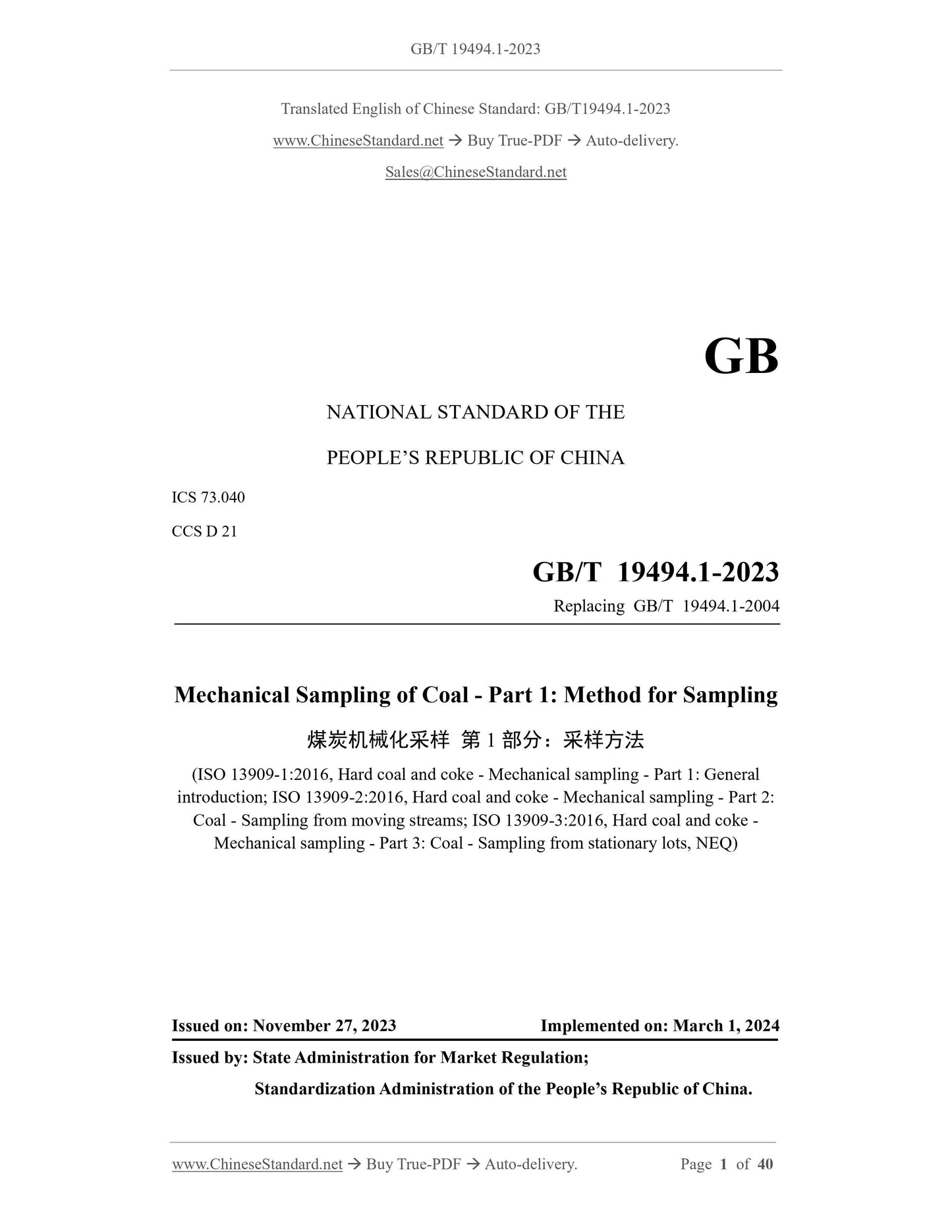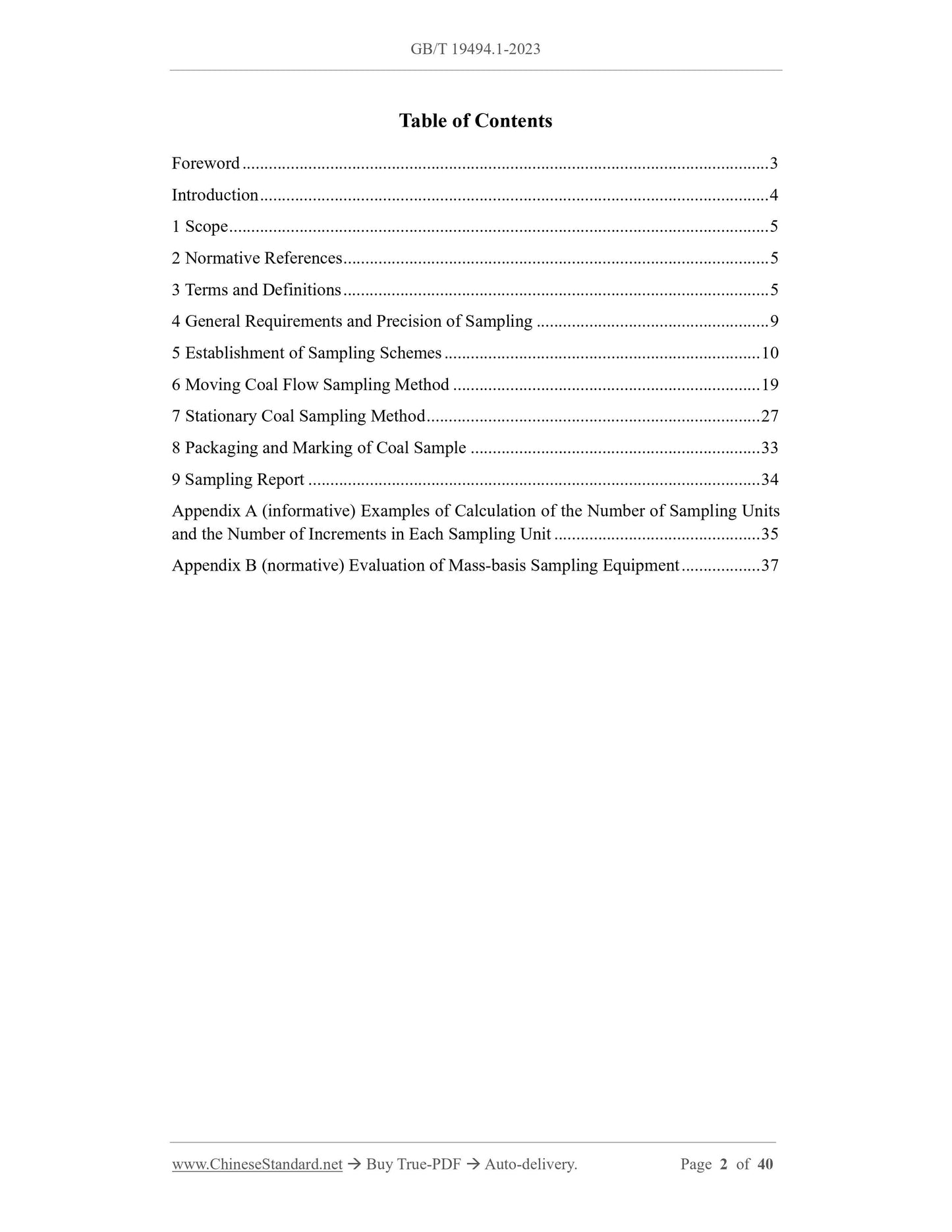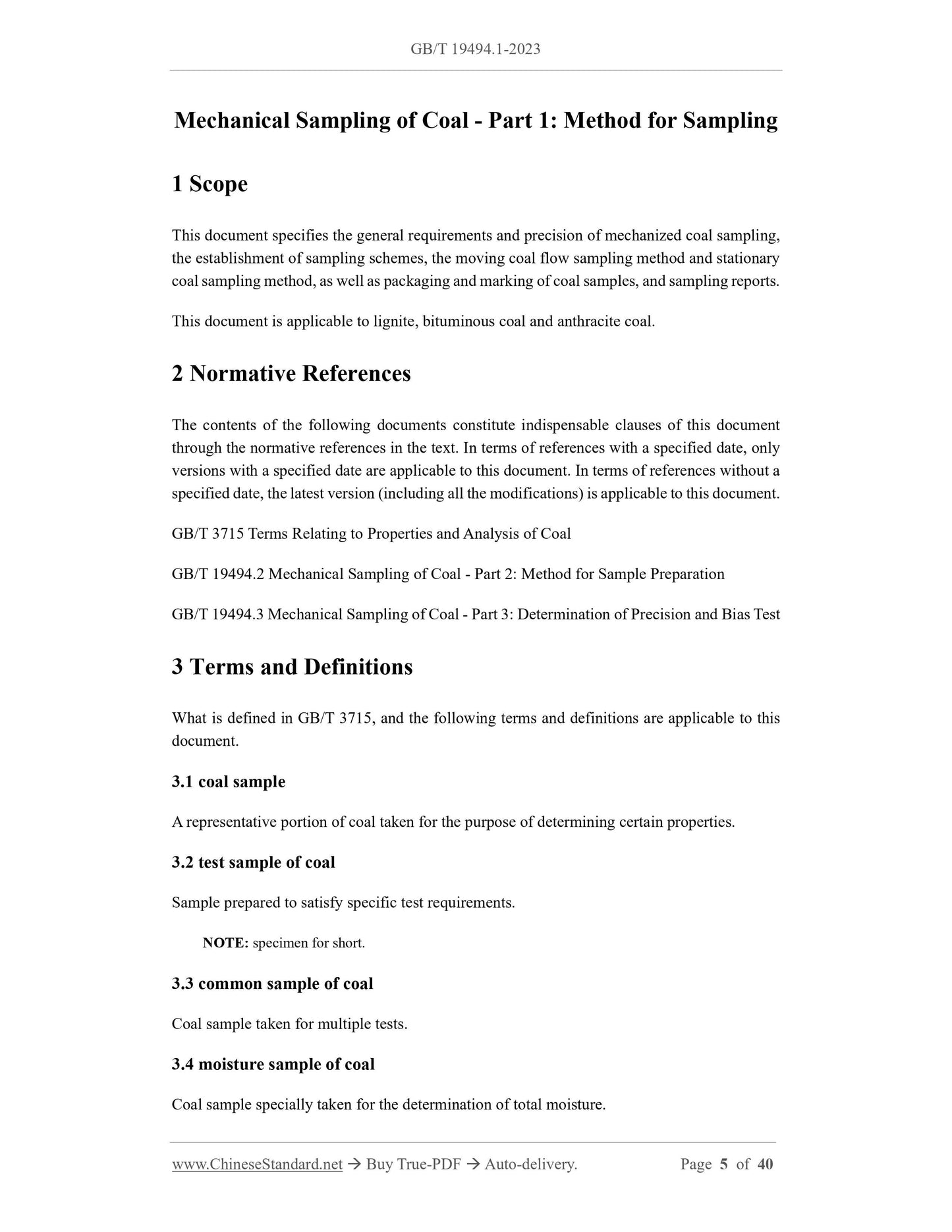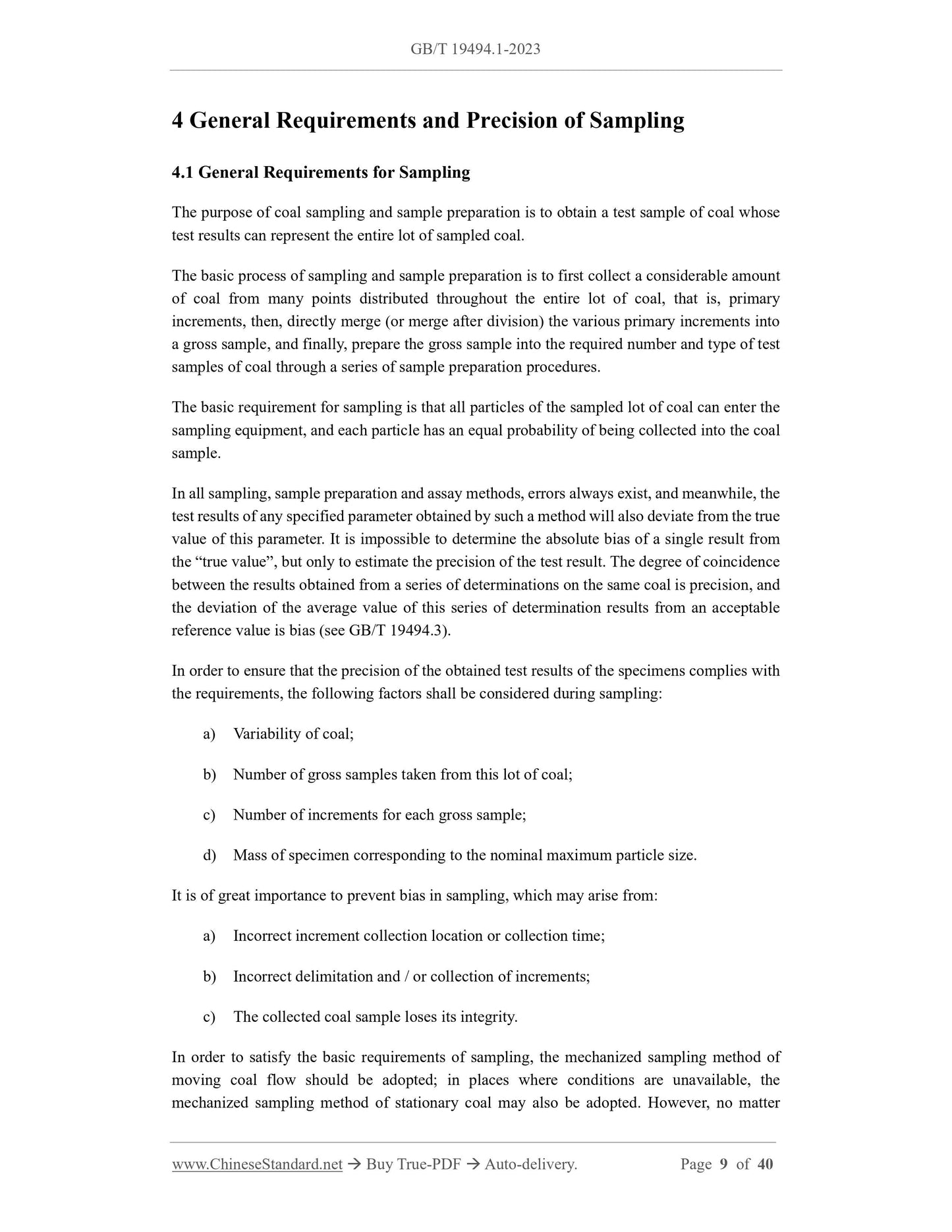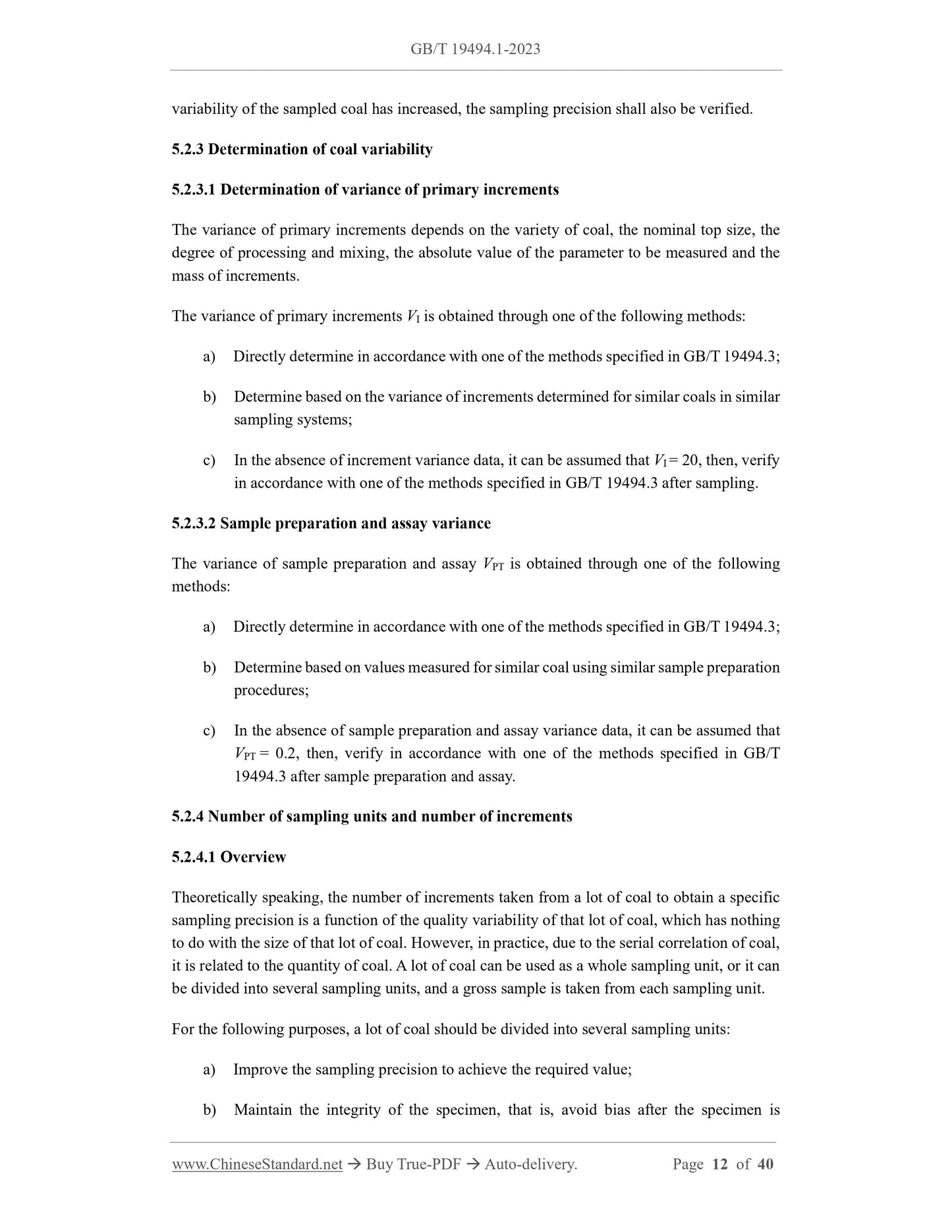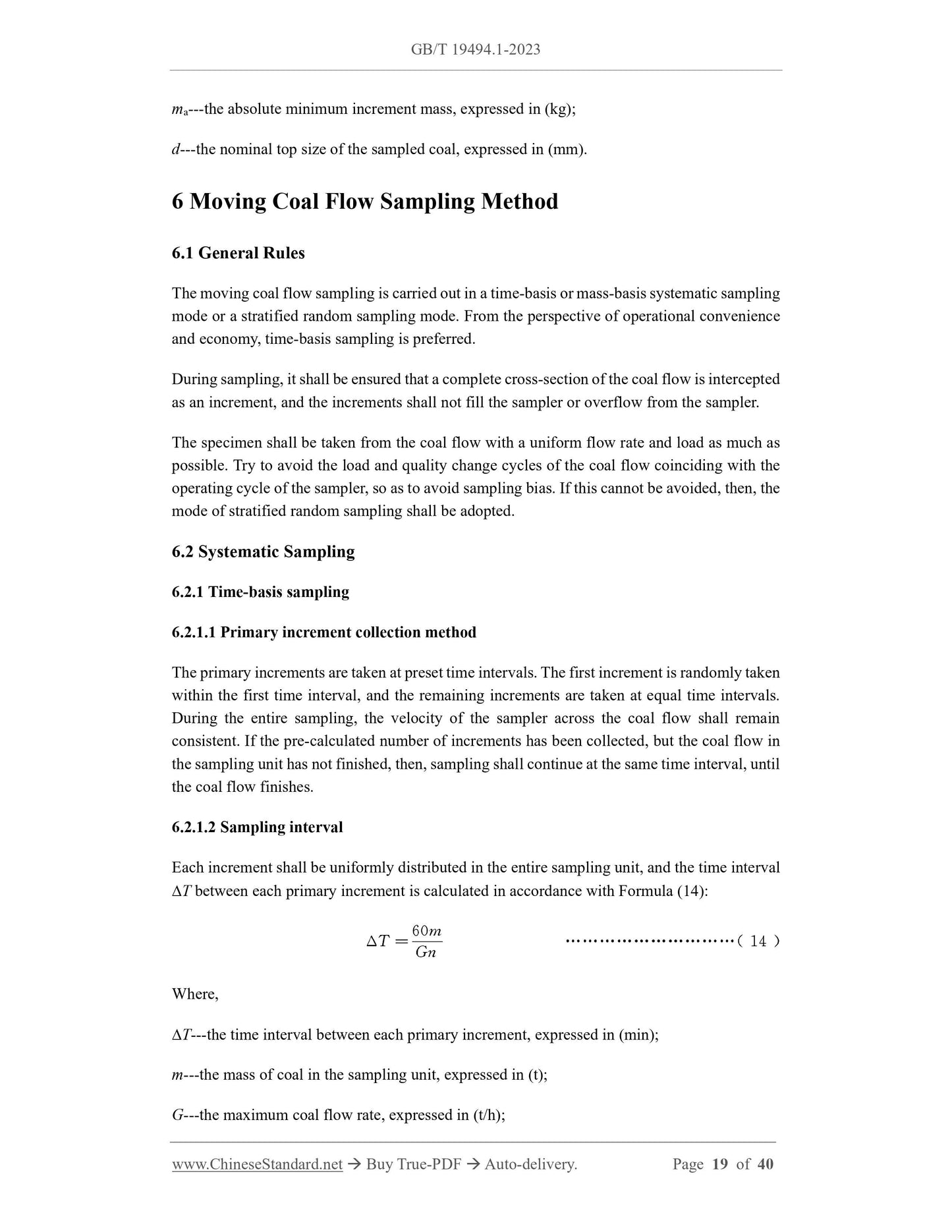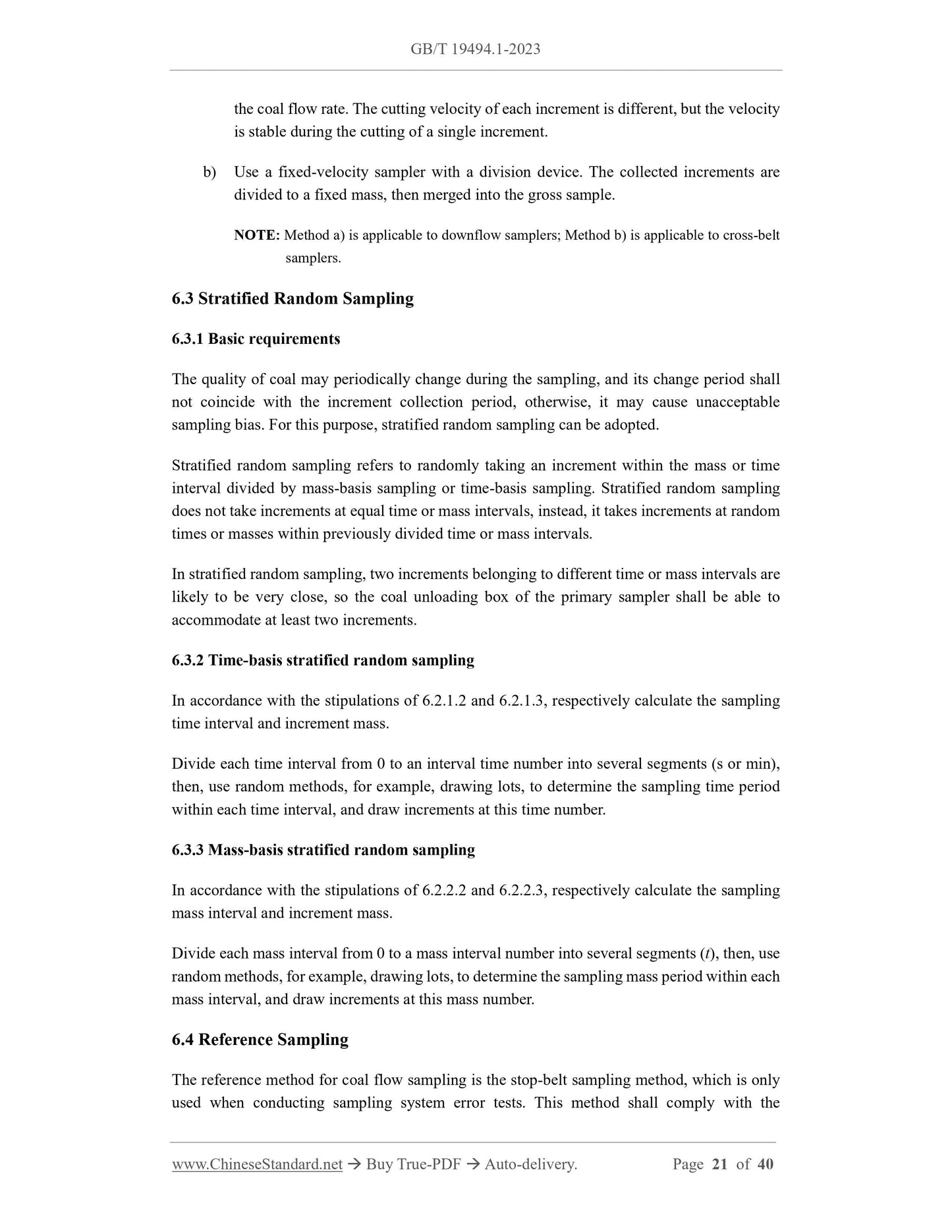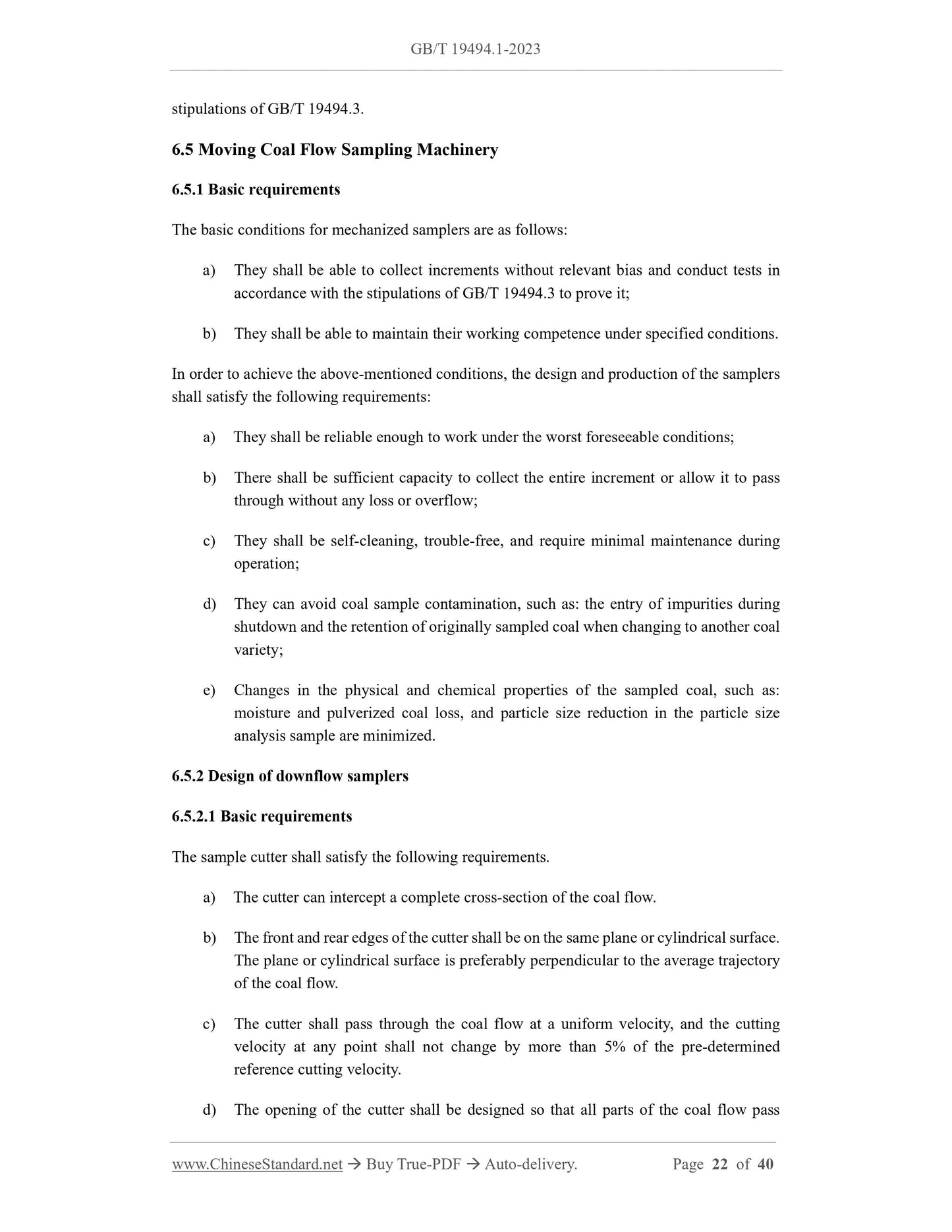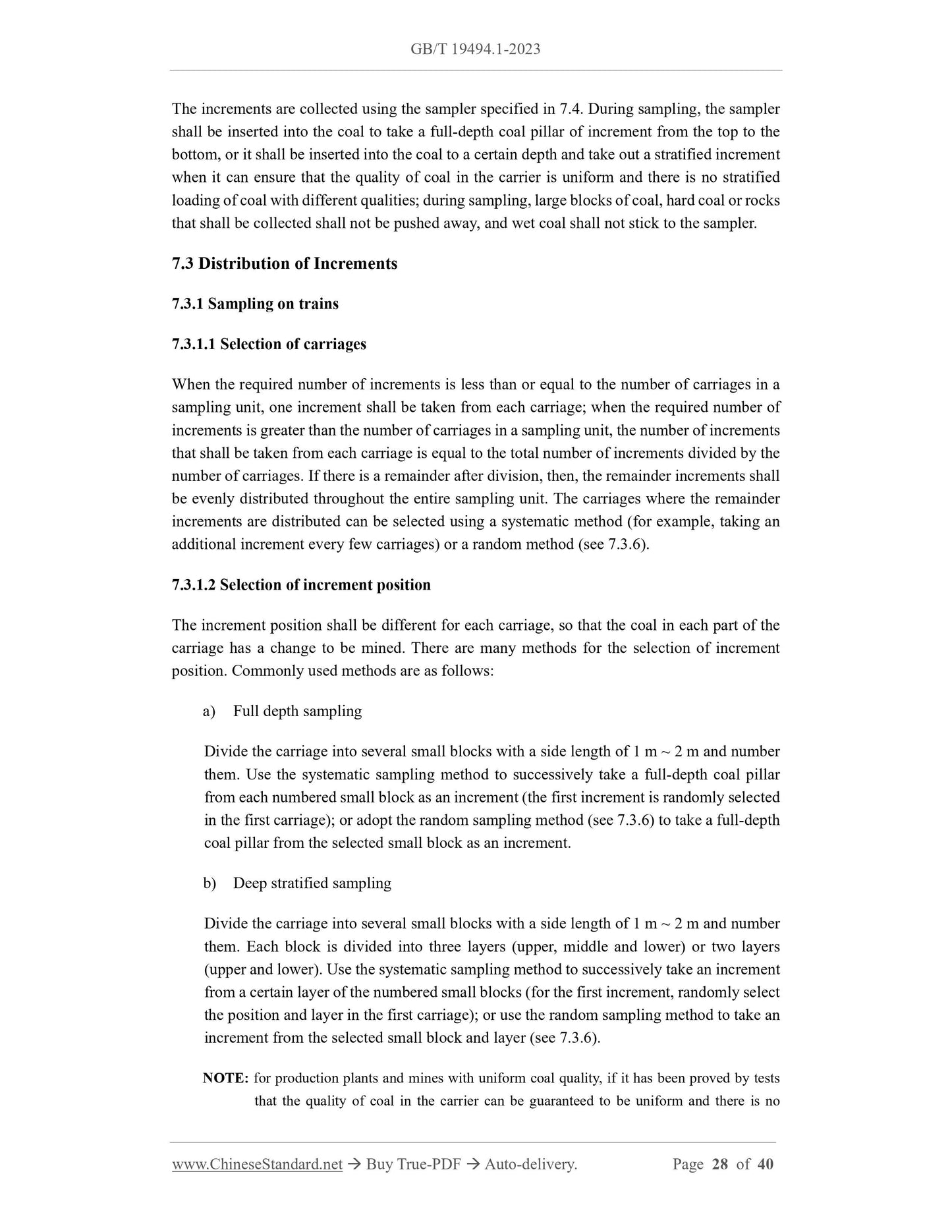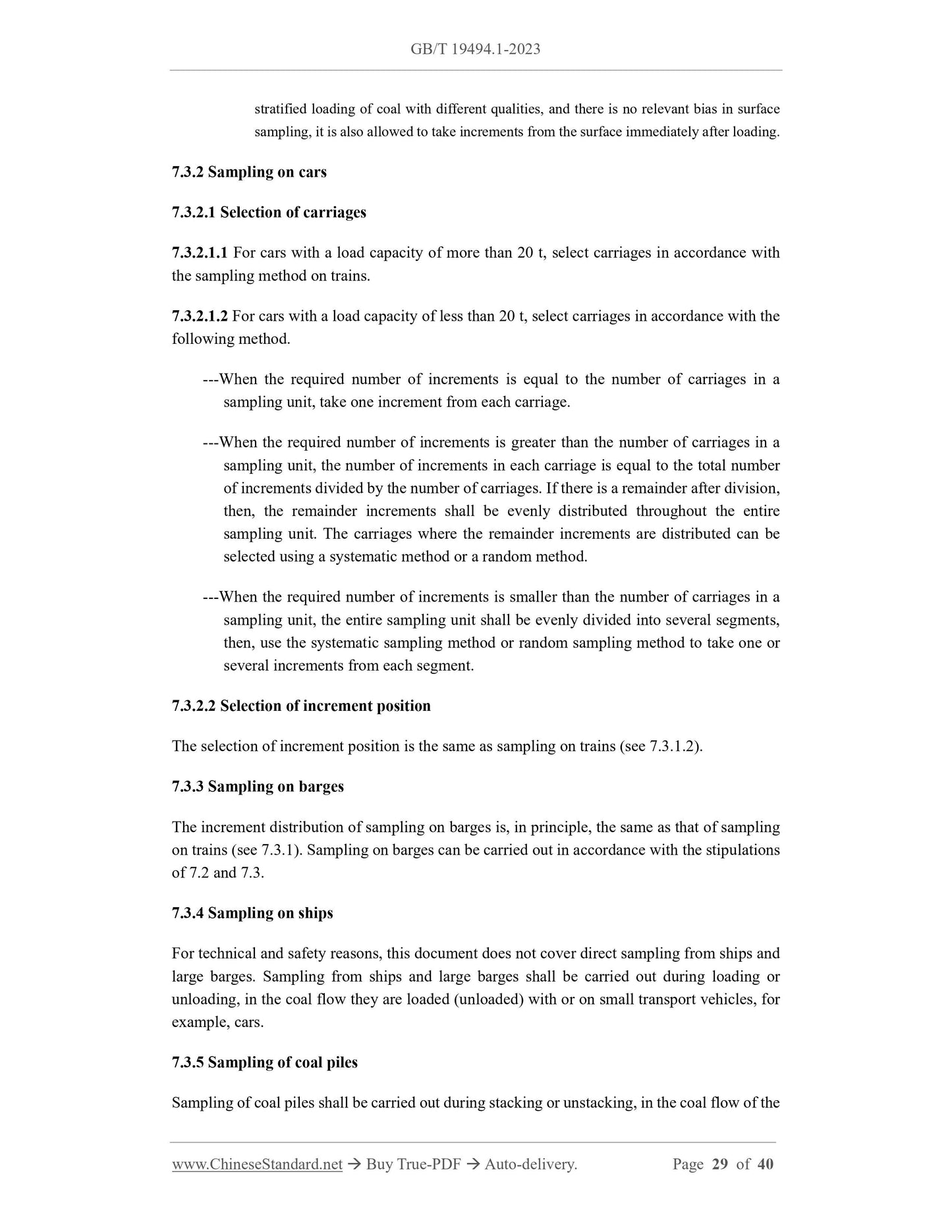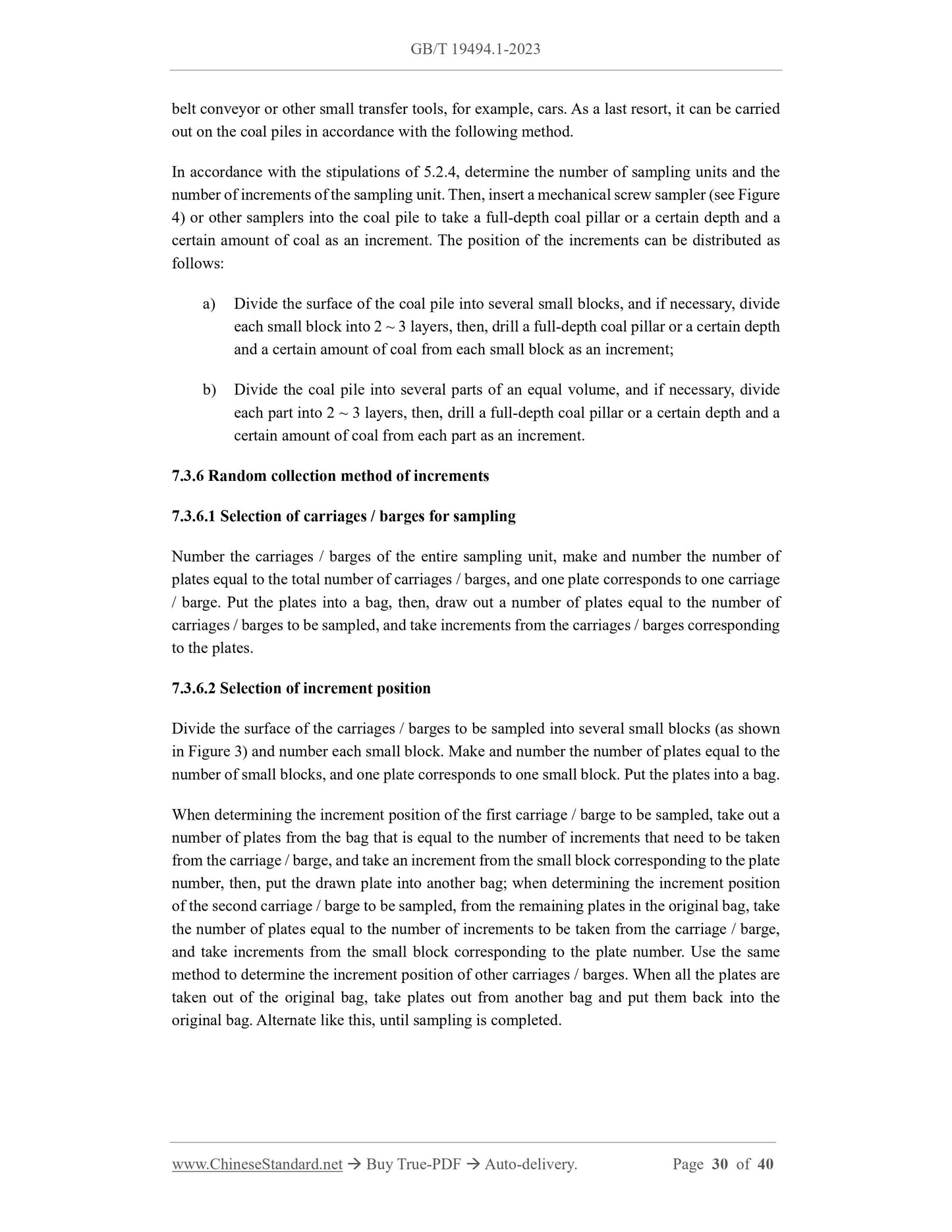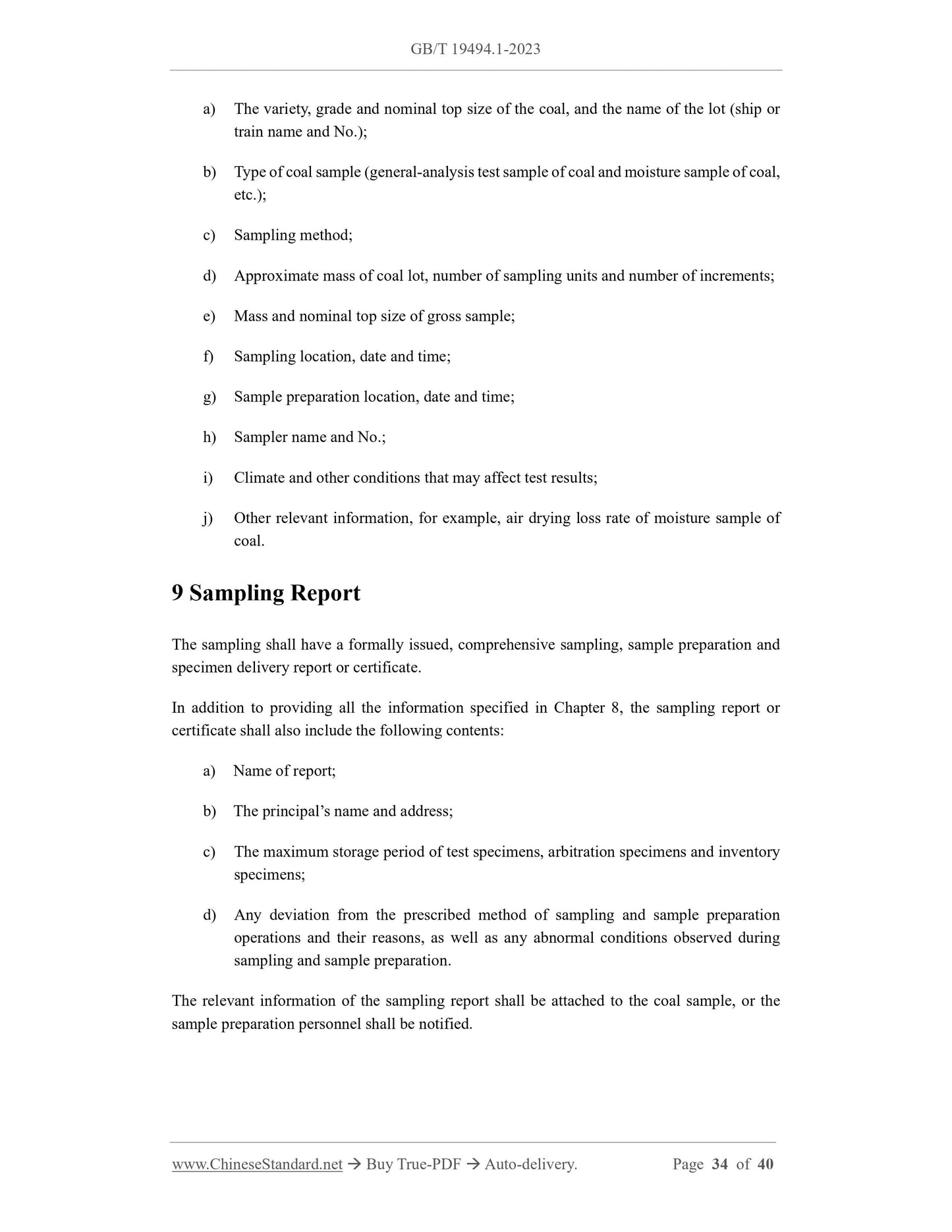1
/
su
12
PayPal, credit cards. Download editable-PDF and invoice in 1 second!
GB/T 19494.1-2023 English PDF (GBT19494.1-2023)
GB/T 19494.1-2023 English PDF (GBT19494.1-2023)
Prezzo di listino
$440.00 USD
Prezzo di listino
Prezzo scontato
$440.00 USD
Prezzo unitario
/
per
Spese di spedizione calcolate al check-out.
Impossibile caricare la disponibilità di ritiro
Delivery: 3 seconds. Download true-PDF + Invoice.
Get QUOTATION in 1-minute: Click GB/T 19494.1-2023
Historical versions: GB/T 19494.1-2023
Preview True-PDF (Reload/Scroll if blank)
GB/T 19494.1-2023: Mechanical sampling of coal -- Part 1: Method for sampling
GB/T 19494.1-2023
GB
NATIONAL STANDARD OF THE
PEOPLE’S REPUBLIC OF CHINA
ICS 73.040
CCS D 21
Replacing GB/T 19494.1-2004
Mechanical Sampling of Coal - Part 1: Method for Sampling
(ISO 13909-1:2016, Hard coal and coke - Mechanical sampling - Part 1: General
introduction; ISO 13909-2:2016, Hard coal and coke - Mechanical sampling - Part 2:
Coal - Sampling from moving streams; ISO 13909-3:2016, Hard coal and coke -
Mechanical sampling - Part 3: Coal - Sampling from stationary lots, NEQ)
ISSUED ON: NOVEMBER 27, 2023
IMPLEMENTED ON: MARCH 1, 2024
Issued by: State Administration for Market Regulation;
Standardization Administration of the People’s Republic of China.
Table of Contents
Foreword ... 3
Introduction ... 4
1 Scope ... 5
2 Normative References ... 5
3 Terms and Definitions ... 5
4 General Requirements and Precision of Sampling ... 9
5 Establishment of Sampling Schemes ... 10
6 Moving Coal Flow Sampling Method ... 19
7 Stationary Coal Sampling Method ... 27
8 Packaging and Marking of Coal Sample ... 33
9 Sampling Report ... 34
Appendix A (informative) Examples of Calculation of the Number of Sampling Units
and the Number of Increments in Each Sampling Unit ... 35
Appendix B (normative) Evaluation of Mass-basis Sampling Equipment ... 37
Mechanical Sampling of Coal - Part 1: Method for Sampling
1 Scope
This document specifies the general requirements and precision of mechanized coal sampling,
the establishment of sampling schemes, the moving coal flow sampling method and stationary
coal sampling method, as well as packaging and marking of coal samples, and sampling reports.
This document is applicable to lignite, bituminous coal and anthracite coal.
2 Normative References
The contents of the following documents constitute indispensable clauses of this document
through the normative references in the text. In terms of references with a specified date, only
versions with a specified date are applicable to this document. In terms of references without a
specified date, the latest version (including all the modifications) is applicable to this document.
GB/T 3715 Terms Relating to Properties and Analysis of Coal
GB/T 19494.2 Mechanical Sampling of Coal - Part 2: Method for Sample Preparation
GB/T 19494.3 Mechanical Sampling of Coal - Part 3: Determination of Precision and Bias Test
3 Terms and Definitions
What is defined in GB/T 3715, and the following terms and definitions are applicable to this
document.
3.1 coal sample
A representative portion of coal taken for the purpose of determining certain properties.
3.2 test sample of coal
Sample prepared to satisfy specific test requirements.
NOTE: specimen for short.
3.3 common sample of coal
Coal sample taken for multiple tests.
3.4 moisture sample of coal
Coal sample specially taken for the determination of total moisture.
4 General Requirements and Precision of Sampling
4.1 General Requirements for Sampling
The purpose of coal sampling and sample preparation is to obtain a test sample of coal whose
test results can represent the entire lot of sampled coal.
The basic process of sampling and sample preparation is to first collect a considerable amount
of coal from many points distributed throughout the entire lot of coal, that is, primary
increments, then, directly merge (or merge after division) the various primary increments into
a gross sample, and finally, prepare the gross sample into the required number and type of test
samples of coal through a series of sample preparation procedures.
The basic requirement for sampling is that all particles of the sampled lot of coal can enter the
sampling equipment, and each particle has an equal probability of being collected into the coal
sample.
In all sampling, sample preparation and assay methods, errors always exist, and meanwhile, the
test results of any specified parameter obtained by such a method will also deviate from the true
value of this parameter. It is impossible to determine the absolute bias of a single result from
the “true value”, but only to estimate the precision of the test result. The degree of coincidence
between the results obtained from a series of determinations on the same coal is precision, and
the deviation of the average value of this series of determination results from an acceptable
reference value is bias (see GB/T 19494.3).
In order to ensure that the precision of the obtained test results of the specimens complies with
the requirements, the following factors shall be considered during sampling:
a) Variability of coal;
b) Number of gross samples taken from this lot of coal;
c) Number of increments for each gross sample;
d) Mass of specimen corresponding to the nominal maximum particle size.
It is of great importance to prevent bias in sampling, which may arise from:
a) Incorrect increment collection location or collection time;
b) Incorrect delimitation and / or collection of increments;
c) The collected coal sample loses its integrity.
In order to satisfy the basic requirements of sampling, the mechanized sampling method of
moving coal flow should be adopted; in places where conditions are unavailable, the
mechanized sampling method of stationary coal may also be adopted. However, no matter
variability of the sampled coal has increased, the sampling precision shall also be verified.
5.2.3 Determination of coal variability
5.2.3.1 Determination of variance of primary increments
The variance of primary increments depends on the variety of coal, the nominal top size, the
degree of processing and mixing, the absolute value of the parameter to be measured and the
mass of increments.
The variance of primary increments VI is obtained through one of the following methods:
a) Directly determine in accordance with one of the methods specified in GB/T 19494.3;
b) Determine based on the variance of increments determined for similar coals in similar
sampling systems;
c) In the absence of increment variance data, it can be assumed that VI = 20, then, verify
in accordance with one of the methods specified in GB/T 19494.3 after sampling.
5.2.3.2 Sample preparation and assay variance
The variance of sample preparation and assay VPT is obtained through one of the following
methods:
a) Directly determine in accordance with one of the methods specified in GB/T 19494.3;
b) Determine based on values measured for similar coal using similar sample preparation
procedures;
c) In the absence of sample preparation and assay variance data, it can be assumed that
VPT = 0.2, then, verify in accordance with one of the methods specified in GB/T
19494.3 after sample preparation and assay.
5.2.4 Number of sampling units and number of increments
5.2.4.1 Overview
Theoretically speaking, the number of increments taken from a lot of coal to obtain a specific
sampling precision is a function of the quality variability of that lot of coal, which has nothing
to do with the size of that lot of coal. However, in practice, due to the serial correlation of coal,
it is related to the quantity of coal. A lot of coal can be used as a whole sampling unit, or it can
be divided into several sampling units, and a gross sample is taken from each sampling unit.
For the following purposes, a lot of coal should be divided into several sampling units:
a) Improve the sampling precision to achieve the required value;
b) Maintain the integrity of the specimen, that is, avoid bias after the specimen is <...
Get QUOTATION in 1-minute: Click GB/T 19494.1-2023
Historical versions: GB/T 19494.1-2023
Preview True-PDF (Reload/Scroll if blank)
GB/T 19494.1-2023: Mechanical sampling of coal -- Part 1: Method for sampling
GB/T 19494.1-2023
GB
NATIONAL STANDARD OF THE
PEOPLE’S REPUBLIC OF CHINA
ICS 73.040
CCS D 21
Replacing GB/T 19494.1-2004
Mechanical Sampling of Coal - Part 1: Method for Sampling
(ISO 13909-1:2016, Hard coal and coke - Mechanical sampling - Part 1: General
introduction; ISO 13909-2:2016, Hard coal and coke - Mechanical sampling - Part 2:
Coal - Sampling from moving streams; ISO 13909-3:2016, Hard coal and coke -
Mechanical sampling - Part 3: Coal - Sampling from stationary lots, NEQ)
ISSUED ON: NOVEMBER 27, 2023
IMPLEMENTED ON: MARCH 1, 2024
Issued by: State Administration for Market Regulation;
Standardization Administration of the People’s Republic of China.
Table of Contents
Foreword ... 3
Introduction ... 4
1 Scope ... 5
2 Normative References ... 5
3 Terms and Definitions ... 5
4 General Requirements and Precision of Sampling ... 9
5 Establishment of Sampling Schemes ... 10
6 Moving Coal Flow Sampling Method ... 19
7 Stationary Coal Sampling Method ... 27
8 Packaging and Marking of Coal Sample ... 33
9 Sampling Report ... 34
Appendix A (informative) Examples of Calculation of the Number of Sampling Units
and the Number of Increments in Each Sampling Unit ... 35
Appendix B (normative) Evaluation of Mass-basis Sampling Equipment ... 37
Mechanical Sampling of Coal - Part 1: Method for Sampling
1 Scope
This document specifies the general requirements and precision of mechanized coal sampling,
the establishment of sampling schemes, the moving coal flow sampling method and stationary
coal sampling method, as well as packaging and marking of coal samples, and sampling reports.
This document is applicable to lignite, bituminous coal and anthracite coal.
2 Normative References
The contents of the following documents constitute indispensable clauses of this document
through the normative references in the text. In terms of references with a specified date, only
versions with a specified date are applicable to this document. In terms of references without a
specified date, the latest version (including all the modifications) is applicable to this document.
GB/T 3715 Terms Relating to Properties and Analysis of Coal
GB/T 19494.2 Mechanical Sampling of Coal - Part 2: Method for Sample Preparation
GB/T 19494.3 Mechanical Sampling of Coal - Part 3: Determination of Precision and Bias Test
3 Terms and Definitions
What is defined in GB/T 3715, and the following terms and definitions are applicable to this
document.
3.1 coal sample
A representative portion of coal taken for the purpose of determining certain properties.
3.2 test sample of coal
Sample prepared to satisfy specific test requirements.
NOTE: specimen for short.
3.3 common sample of coal
Coal sample taken for multiple tests.
3.4 moisture sample of coal
Coal sample specially taken for the determination of total moisture.
4 General Requirements and Precision of Sampling
4.1 General Requirements for Sampling
The purpose of coal sampling and sample preparation is to obtain a test sample of coal whose
test results can represent the entire lot of sampled coal.
The basic process of sampling and sample preparation is to first collect a considerable amount
of coal from many points distributed throughout the entire lot of coal, that is, primary
increments, then, directly merge (or merge after division) the various primary increments into
a gross sample, and finally, prepare the gross sample into the required number and type of test
samples of coal through a series of sample preparation procedures.
The basic requirement for sampling is that all particles of the sampled lot of coal can enter the
sampling equipment, and each particle has an equal probability of being collected into the coal
sample.
In all sampling, sample preparation and assay methods, errors always exist, and meanwhile, the
test results of any specified parameter obtained by such a method will also deviate from the true
value of this parameter. It is impossible to determine the absolute bias of a single result from
the “true value”, but only to estimate the precision of the test result. The degree of coincidence
between the results obtained from a series of determinations on the same coal is precision, and
the deviation of the average value of this series of determination results from an acceptable
reference value is bias (see GB/T 19494.3).
In order to ensure that the precision of the obtained test results of the specimens complies with
the requirements, the following factors shall be considered during sampling:
a) Variability of coal;
b) Number of gross samples taken from this lot of coal;
c) Number of increments for each gross sample;
d) Mass of specimen corresponding to the nominal maximum particle size.
It is of great importance to prevent bias in sampling, which may arise from:
a) Incorrect increment collection location or collection time;
b) Incorrect delimitation and / or collection of increments;
c) The collected coal sample loses its integrity.
In order to satisfy the basic requirements of sampling, the mechanized sampling method of
moving coal flow should be adopted; in places where conditions are unavailable, the
mechanized sampling method of stationary coal may also be adopted. However, no matter
variability of the sampled coal has increased, the sampling precision shall also be verified.
5.2.3 Determination of coal variability
5.2.3.1 Determination of variance of primary increments
The variance of primary increments depends on the variety of coal, the nominal top size, the
degree of processing and mixing, the absolute value of the parameter to be measured and the
mass of increments.
The variance of primary increments VI is obtained through one of the following methods:
a) Directly determine in accordance with one of the methods specified in GB/T 19494.3;
b) Determine based on the variance of increments determined for similar coals in similar
sampling systems;
c) In the absence of increment variance data, it can be assumed that VI = 20, then, verify
in accordance with one of the methods specified in GB/T 19494.3 after sampling.
5.2.3.2 Sample preparation and assay variance
The variance of sample preparation and assay VPT is obtained through one of the following
methods:
a) Directly determine in accordance with one of the methods specified in GB/T 19494.3;
b) Determine based on values measured for similar coal using similar sample preparation
procedures;
c) In the absence of sample preparation and assay variance data, it can be assumed that
VPT = 0.2, then, verify in accordance with one of the methods specified in GB/T
19494.3 after sample preparation and assay.
5.2.4 Number of sampling units and number of increments
5.2.4.1 Overview
Theoretically speaking, the number of increments taken from a lot of coal to obtain a specific
sampling precision is a function of the quality variability of that lot of coal, which has nothing
to do with the size of that lot of coal. However, in practice, due to the serial correlation of coal,
it is related to the quantity of coal. A lot of coal can be used as a whole sampling unit, or it can
be divided into several sampling units, and a gross sample is taken from each sampling unit.
For the following purposes, a lot of coal should be divided into several sampling units:
a) Improve the sampling precision to achieve the required value;
b) Maintain the integrity of the specimen, that is, avoid bias after the specimen is <...
Share
